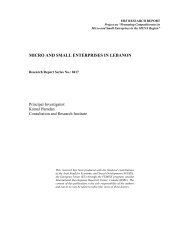local employment growth in the coastal area of tunisia - Economic ...
local employment growth in the coastal area of tunisia - Economic ...
local employment growth in the coastal area of tunisia - Economic ...
Create successful ePaper yourself
Turn your PDF publications into a flip-book with our unique Google optimized e-Paper software.
3.2 Model <strong>of</strong> <strong>employment</strong> <strong>growth</strong><br />
We based our econometric model on a specification used by Blien et al. (2006), who<br />
considered a dynamic panel model for West Germany. We extend this specification <strong>in</strong> order<br />
to <strong>in</strong>tegrate <strong>the</strong> spatial dimension used by Elhorst (2005) specify<strong>in</strong>g a dynamic spatial panel<br />
data model. Our spatial panel data dynamic model will be:<br />
m<br />
m<br />
lemp s,<br />
d , t = α + ρWlemps,<br />
d , t + ∑ βllemps,<br />
d , t −l<br />
+ ∑δ<br />
l X s,<br />
d , t −l<br />
+ fs<br />
, d + ηt<br />
+ ε s,<br />
d , t<br />
l = 1<br />
l = 0<br />
lemp s,<br />
d , t is <strong>the</strong> log <strong>of</strong> <strong>employment</strong> rate <strong>of</strong> sector s , ( s = 1,...,<br />
S ), <strong>in</strong> <strong>area</strong> d ( d 1,...,<br />
n<br />
t ( t = 1,...,<br />
T ). Wlemp s,<br />
d , t is <strong>the</strong> spatially lagged dependant variable ( lemp s,<br />
d , t ) and lemps, d , t −l<br />
(6)<br />
= ) at time<br />
are <strong>the</strong> timely lagged dependent variables. X s,<br />
d , t −l<br />
are <strong>the</strong> current or lagged covariates<br />
(specialization, diversity, competition, agglomeration, size and wages). f s,<br />
d is a fixed time<br />
specific effect, ηt is a time effect and ε s , d , t is <strong>the</strong> standard error term.<br />
3.3 Tests and econometric estimation procedure<br />
3.3.1 Tests for spatial correlation<br />
To deal with dynamic spatial correlation, we use an Exploratory Spatial Data Analysis<br />
(ESDA), proposed by Ansel<strong>in</strong> (1996). The ESDA technique enables us to test and identify<br />
spatial configuration <strong>of</strong> <strong>in</strong>dustrial <strong>employment</strong> for each sector. The first step to deal with<br />
georeferenced data consists to check <strong>the</strong> presence <strong>of</strong> spatial dependence. Moran’s I <strong>in</strong>dex is<br />
<strong>the</strong> most commonly used <strong>in</strong>dex detect<strong>in</strong>g global autocorrelation <strong>of</strong> a variable <strong>of</strong> <strong>in</strong>terest, x i .<br />
Roughly speak<strong>in</strong>g <strong>the</strong> Moran <strong>in</strong>dex is a cross product correlation measure that <strong>in</strong>corporates<br />
“space” through a spatial weight matrix W .<br />
Formally, let n be <strong>the</strong> number <strong>of</strong> elementary spatial unit and x i <strong>the</strong> <strong>employment</strong> at <strong>the</strong> i<br />
spatial unit. The Moran’s <strong>in</strong>dex is def<strong>in</strong>ed as:<br />
I<br />
n<br />
n<br />
n<br />
∑∑<br />
=<br />
i=<br />
1 j=<br />
1<br />
ij<br />
n<br />
S<br />
w ( x − x)(<br />
x − x)<br />
∑<br />
0<br />
i=<br />
1<br />
i<br />
2<br />
( x − x)<br />
i<br />
j<br />
where x denote global mean, w ij is <strong>the</strong> ij th element <strong>of</strong> <strong>the</strong> spatial weight<strong>in</strong>g matrix W and<br />
S<br />
0<br />
=<br />
n<br />
n<br />
∑∑<br />
i=<br />
1 j=<br />
1<br />
w<br />
ij<br />
.<br />
Spatial filter<strong>in</strong>g<br />
After detect<strong>in</strong>g spatial autocorrelation us<strong>in</strong>g Moran’s <strong>in</strong>dex, <strong>the</strong> question is how to handle it.<br />
One approach deal<strong>in</strong>g with this problem is to spatially filter <strong>the</strong> data. This approach seeks to<br />
transform a spatially dependent variable <strong>in</strong>to two components: <strong>the</strong> filtered variable and <strong>the</strong><br />
purely spatial effect. In our analysis, we use <strong>the</strong> Getis’s G i specification to remove spatial<br />
effect. Getis’s <strong>in</strong>dex is presented as:<br />
n<br />
∑<br />
Gi ( d)<br />
=<br />
j = 1<br />
wij<br />
( d)<br />
x j<br />
n<br />
x<br />
, i ≠ j<br />
∑<br />
j = 1<br />
j<br />
(7)<br />
(8)<br />
8

















